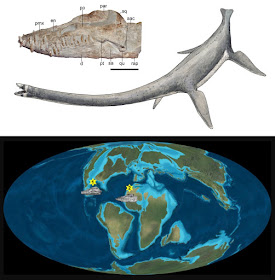 |
|
Illustration by Hyrotrioskjan hyrotrioskjan.deviantart.com
|
Highlights
• The Late Cretaceous elasmosaurid species Libonectes atlasense and Libonectes morgani are likely synonymous.
• Fossils assigned to Libonectes morgani collectively constitute one of the best-known Elasmosaurid taxa.
• The palaeogeographical distribution of Libonectes morgani evidences trans-Atlantic dispersal amongst multiple Late Cretaceous plesiosaurian clades.
Abstract
The holotype of Libonectes atlasense is an almost complete skeleton from Upper Cretaceous (mid-Turonian) rocks of the Goulmima area in eastern Morocco. Initial assessment of this specimen in 2005 proposed generic referral based on stratigraphical contemporaneity with Libonectes morgani from the Cenomanian–Turonian of Texas, U.S.A. Nevertheless, relative differences in the profile of the premaxillary-maxillary tooth row, position of the external bony nasal opening, number of teeth and rostral inclination of the mandibular symphysis, proportions of the axial neural arch, and number of cervical and pectoral vertebrae were used to distinguish between these species. As part of an on-going comparative appraisal of elasmosaurid plesiosaurian osteo-anatomy, we re-examined the type and formally referred material of both L. atlasense and L. morgani in order to establish species validity, as well as compile a comparative atlas for use in future works. Our inspections revealed that these reportedly distinct species-level fossils are in fact virtually indistinguishable in gross morphology. Indeed, the only substantial difference occurs in relative prominence of the midline keel along the mandibular symphysis, which might be explained by intraspecific variation. Furthermore, our observations permit an amendment to the published generic diagnosis of Libonectes with the confirmation of important states such as the likely presence of a pectoral bar, distocaudal expansion of the humerus, and an epipodial foramen. In addition, novel features include a prominent ‘prong-like’ ventral midline process on the coracoids, and the development of a median pelvic bar that encloses a central fenestration. The composite remains of L. morgani thus constitute one of the most complete elasmosaurid skeletal hypodigms documented worldwide, and evidence a trans-Atlantic distribution for this apparently dispersive species during the early–Late Cretaceous.
 |
| Libonectes
Illustration by Hyrotrioskjan hyrotrioskjan.deviantart.com
|
Sven Sachs and Benjamin P. Kear. 2017. Redescription of the Elasmosaurid Plesiosaurian Libonectes atlasense from the Upper Cretaceous of Morocco. Cretaceous Research. 74; 205–222. DOI: 10.1016/j.cretres.2017.02.017
